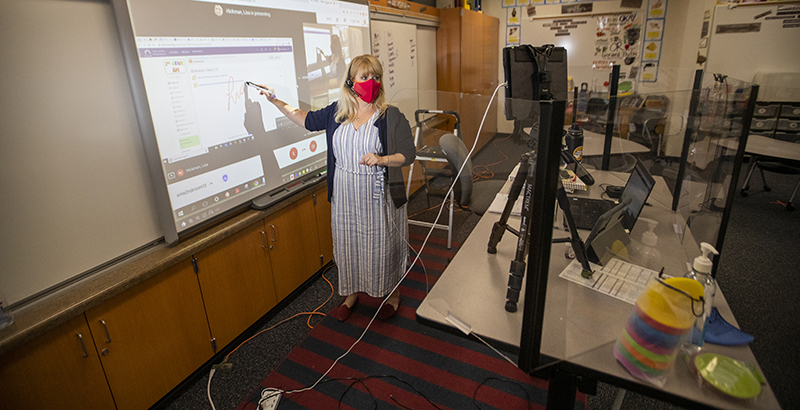Analysis: Mentors, Team Teaching, 7-Week Class Cycles 12 Months a Year — Some School Innovations in Staffing and Scheduling During COVID-19

An Arkansas school district has one teacher leading instruction for several classes while others support children in small groups. A suburban Cleveland elementary school teamed up teachers and restructured its school day to expand staff planning time. A St. Louis charter school is making sure every educator also serves as an education navigator or coach for a pod of 10 students.
The coronavirus crisis is prompting schools and districts to embrace innovative staffing and scheduling strategies that are extending the reach of great teachers, leveraging co-teaching models in new ways and providing more support for students and educators.
A recent survey by the RAND Corp. found that 91 percent of U.S. school districts and charter management organizations anticipated revising work roles and job duties for teachers or other staff during the pandemic. About one in five said they have already adopted, plan to adopt or are considering adopting virtual schools even after the current crisis ends, in response to parent and student demands.
The question is what it will take to sustain and expand these innovative staffing models after the pandemic. In a recent report for FutureEd, we explored a range of new staffing strategies as well as barriers to innovation, such as rigid labor contracts and the reluctance to break from traditional practices.
We looked first at ways to extend the reach of highly skilled teachers, both to provide high-quality instruction to more students and to support fellow educators. At the nonprofit Cadence Learning, which serves some 8,800 students in grades 3 to 8 in 11 states and the District of Columbia, a team of national mentor teachers supports online instruction in partner schools throughout the country. Each of the dozen or so mentors delivers a lesson on the screen along with three to five students who discuss the lesson and ask questions. The teachers in the partner schools can play the recording for their students or teach a live version of the lesson themselves using virtual breakout rooms.
“It’s like being able to sit in the back of the room of the best teacher in the building for weeks at a time and see his or her moves and adapt them and make them your own,” says Steven Wilson, a co-founder of Cadence and the founder and former chief executive of New York City’s Ascend charter school network. Cadence was initially known as the National Summer School Initiative, which launched last summer in response to the pandemic. A recent report on the summer program by researchers at the University of Virginia found the vast majority of partner teachers reported that their students improved their academic abilities over the course of the program. Students also rated the experience highly.
Districts are also expanding co-teaching models and teaching teams to enable more small-group and individual support for students and distribute responsibilities based on teacher strengths. One model is Opportunity Culture, an initiative of Public Impact. More than 360 schools across 10 states belong to the network.
Multi-classroom leaders teach part time and lead small, collaborative teams of two to eight teachers, paraprofessionals and teachers in training in the same grade or subject. During the pandemic, Public Impact has used this approach to prioritize face-to-face video time within small groups, which helps motivate students and connect emotionally with teachers.
“COVID has highlighted the level of guidance and support teachers need to help all students learn,” says Bryan Hassel, co-president of Public Impact. “That need pre-dated COVID and will outlast it.”
Gentry Public Schools in Arkansas assigned some of its elementary school educators to multi-classroom teams last March, just as physical buildings closed. The district turned to the multi-classroom leaders, who receive extra pay, to identify priority standards and content for each grade, help with school reopening plans this past fall and serve as liaisons between the administration and the teaching staff.
At Lander Elementary School in Mayfield Heights, Ohio, a Cleveland suburb, Principal Felecia Evans combines a co-teaching model with a restructured school day to support grade-level team planning. Students in each grade now take all their special subjects — such as art, music and physical education — on the same day, so teachers have a full day for team planning. During that time, they review what went well and what didn’t during the past six days.
Scheduling Based on Student Needs
Other schools are moving away from uniform class sizes and time blocks to more flexible models. Dream Charter Schools, a New York City network of four schools serving 1,050 students in East Harlem and the South Bronx, shifted its approach during the pandemic based on students’ developmental needs.
The earliest grades focus on live instruction in small groups and limit screen time. Middle school students have a team of four teachers responsible for an entire grade’s worth of students, including more customized instruction for students on their team. High school students have more independence, attending lectures or seminars a few times a week, then focusing on projects or small-group workshops.
Among the most radical approaches to staffing comes from Kairos Academies, a St. Louis charter middle school that now operates on a seven-week cycle: Students attend school year round — five weeks on and two weeks off; staff have one week off and another for professional development and planning. “We operate in sprints, much like the technology industry,” says Gavin Schiffres, the school’s founder and CEO.
During the professional development periods, educators analyze data from the previous five weeks to ask such questions as, “Who needs extra help with this concept?” and then schedule students for live, small-group tutoring or study halls. Also, every adult at Kairos coaches 10 students, meeting with each several times a week and communicating with families weekly.
Challenges to Innovation
Despite the promise of these innovations, there remain substantial barriers, including rigid labor contracts and, at times, union inflexibility.
In Brevard County, Florida, for example, the teachers union won an agreement last March to limit online instructional time to three hours a day. The Los Angeles Unified School District initially agreed to limit instruction and student support time to four hours a day per teacher and to keep staff meetings to one hour a week. Live teaching via video was encouraged but not required.
While there’s a legitimate need not to overburden teachers, who have their own family demands and often have stepped up in heroic ways in the past year, it’s hard to argue that provisions such as those in Brevard and Los Angeles benefit students.
Teachers union leaders like Randi Weingarten, the president of the American Federation of Teachers, say district officials are largely to blame for failing to embrace innovation. “What I see, unfortunately, is a lot of management who were really resistant to dealing with staffing issues,” Weingarten told me. That’s in part, she said, because of limited resources and guidance and because “school districts are not used to having the entire district have to change on a dime. They’re used to a school or two trying innovation and seeing how it works; but this was everyone, everything, all at the same time.”
Some education leaders have managed to work with unions, such as the Springfield Empowerment Zone in Massachusetts. The network of 15 low-performing schools, established to avoid a state takeover, had developed a three-page contract with the local union long before the pandemic that enables teacher leadership teams in each building to help determine working conditions.
When schools went virtual last spring, zone leaders recruited the best teachers in different content areas to develop lessons students could access remotely at any time. That enabled teachers to focus on providing individual and small-group support for their students. For a summer session, teachers spent time developing lessons or delivering them online.
But with rare exceptions, teachers unions haven’t sought innovative staffing solutions during the pandemic. Instead, an analysis by the National Council on Teacher Quality of COVID-related memoranda of understanding between labor and management in 35 large districts found none related to new staffing structures, although a few dedicated more time for staff planning.
State and district rules and regulations regarding mandatory class size, teacher licensing, required instructional minutes and length of the school day and year also can pose barriers. Another significant challenge may be funding.
New teaching arrangements also confront a nostalgic American ideal of what it means to teach: namely, to remain ever present at the chalkboard, responsible for a roomful of children. To make the best use of the nation’s most talented educators and to truly make teaching more student-centered will require freeing up teachers’ time to plan, to collaborate and to advise and work with students individually, not just in large groups.
Lynn Olson is a senior fellow at FutureEd, a nonpartisan think tank at Georgetown University’s McCourt School of Public Policy. This piece was adapted from the recently published FutureEd report Teaching Innovation: New School Staffing Strategies Inspired by the Pandemic.
Get stories like these delivered straight to your inbox. Sign up for The 74 Newsletter

;)
